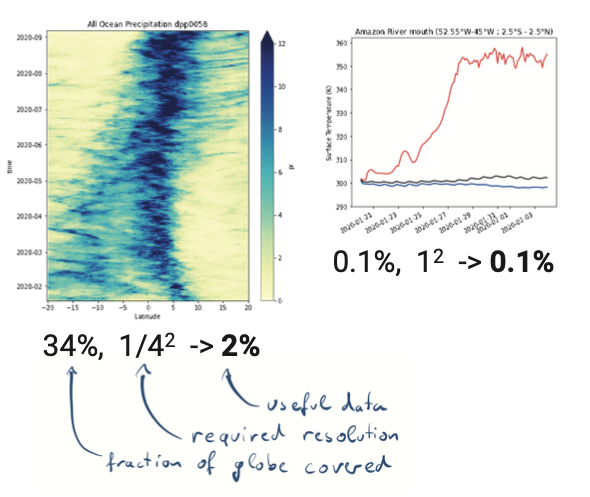Storing data
Florian Ziemen, Tobi Kölling, Lukas Kluft
Datasets
Datasets are

(from xarray docs)
- n-dimensional variables
- shared dimensions
- coordinates
- attributes for metadata
Datasets are not
- a single file
- a storage format
- shaped by storage & handling
Storage and access
Access to subsets


Without subset access and hierarchies, analysis scripts are forced to load way too much data.
Align the ordering of data with read patterns

https://www.unidata.ucar.edu/blogs/developer/entry/chunking_data_why_it_matters
Make a compromise that’s okay-ish for everybody by chunking along all dimensions.
Compress small chunks
- Any access will require uncompressing entire chunks.
- By keeping them small to reduce the amount of data that will be uncompressed but not used.
- Keep them big enough for the compressor to do its job.
- Usually MB-ish blocks are a good compromise.
Use fast compressors
Mapping a dataset to files
Contents of a dataset
- Metadata
- n-d variables consisting of many numbers
netCDF4 / HDF5
- netCDF4, a.k.a. HDF5 stores metadata and chunks in one file.
- Usually a dataset is split across many of these files.
- Loading the dataset requires opening all files.1
Zarr is as simple as it gets.
- .json files for the metadata
- binary files for (compressed) chunks
As chunks are stored separately, this scales for any size of dataset. We are working with a 500 TB dataset in nextGEMS.
Kerchunk + fsspec
Appendix
Performance benchmarks for chunking
| Storage layout, chunk shapes | Read time series (sec) | Read spatial slice (sec) | Performance bias (slowest / fastest) |
|---|---|---|---|
| Contiguous favoring time range | 0.013 | 180 | 14000 |
| Contiguous favoring spatial slice | 200 | 0.012 | 17000 |
| Default (all axes equal) chunks, 4673 x 12 x 16 | 1.4 | 34 | 24 |
| 36 KB chunks, 92 x 9 x 11 | 2.4 | 1.7 | 1.4 |
| 8 KB chunks, 46 x 6 x 8 | 1.4 | 1.1 | 1.2 |
